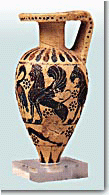

|
Vases of Proto-Corinthian and mainly Corinthian pottery, which were used for carrying perfumes, esential oils, olive oil and wine, were found in different regions and testify to the fact that trade in the |
 |
Originally, this trade net was sustained by adventurers -members of the upper classes- who along with their people were responsible for transactions. In the
There were, however, instances of export prohibition. References have survived in Athens and Selymbria in the Thracian coasts. In Athens only the export of olive oil was allowed and in Selymbria the export of grain had been prohibited for a certain period (Pseudo-Aristotle, Oeconomica 1348b33-1349a3).
|
| |
|
Note: Click on a picture for a brief description. | |